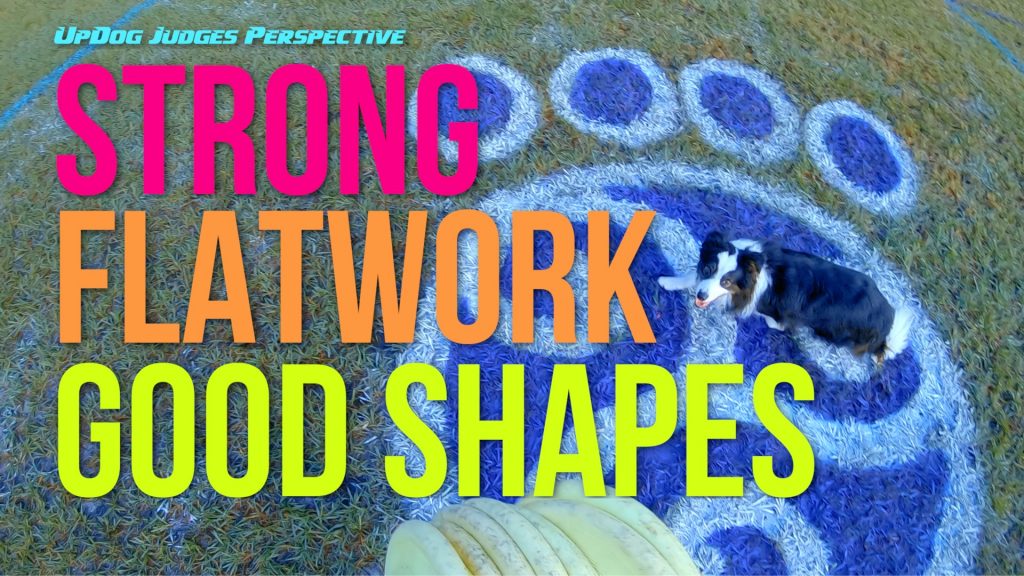
On Flatwork & Shapes in Disc Dog Freestyle
Disc Dog Flatwork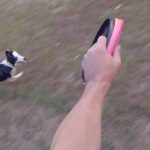 Flatwork is the stuff that happens between the catches. How the team moves and transitions, often without the disc, is flatwork. Flatwork concepts in disc dog are taken from the agility and herding... More and Shapes are related but not the same thing. Just because you have good flatwork doesn’t mean you will have good shapes and vice versa. It is possible to have great Shapes and weak Flatwork. As it is possible to have great Flatwork and weak Shapes.
Flatwork is the stuff that happens between the catches. How the team moves and transitions, often without the disc, is flatwork. Flatwork concepts in disc dog are taken from the agility and herding... More and Shapes are related but not the same thing. Just because you have good flatwork doesn’t mean you will have good shapes and vice versa. It is possible to have great Shapes and weak Flatwork. As it is possible to have great Flatwork and weak Shapes.
Solid Flatwork with Weak Shapes
Apryl & Jolene are a great team. They’ve got solid Flatwork. Apryl moves Jolene around the field well, Jo is responsive to Apryl’s cuing and movement.
If you look at their game with a critical eye or from above, you can see that the Shapes of the game are pretty standard and repetitive. Jo runs in linear fashion with very little arcing and most all the throws are delivered with handler, dog, and disc arranged in a line. On nearly every out throw, Jolene leaves from close to the handler chasing a disc.
This type of movement is one aspect of Shapes – linear. There are 2 instances of some kind of different shape being employed and they’re notated by that triangle graphic.
Apryl makes up for this to some degree with handler movement, but in this performance it’s not used to alter the linear nature of nearly all the dog’s and Team MovementTeam Movement is how dog and handler move, as a team, out there on the field. It is a judging category in some organizations and certainly is a focus of many judges, players,... More.
Strong Flatwork Good Shapes
Eppie & I have a bit more Flatwork going on and more diversity in patterns. This diversity of lines and arcs should equate to a higher Shapes score and better Team Movement scores.
Accounting for and handling the greater diversity of Shapes and lines allows for and all but requires more Flatwork. This is that typical relationship between Flatwork and Shapes that most people anticipate.
Why is This Happening?
The tendency of many disc doggers is to present this as a “border collie” vs “not-a-border collie” thing. It’s not. There are mechanical issues with Jolene and Apryl’s game that are promoting the lack of diversity in Shapes.
Drop Location
You can’t run a dog with solid shapes without a solid cued Drop. Stimulus control over the drop is required to get the drop to happen at a time and place to allow for Shapes to happen.
A dog with a latent drop winds up close to the handler before being ready to chase another disc. A dog who will only drop on or near the handler is far more likely to run in linear fashion, as the handler, dog, and disc will wind up in a line on the throw.
A latent drop on the Zig Zag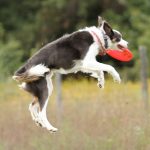 A Zig Zag is a series of catches in smooth succession that forces the dog to move back and forth across the field. Usually performed at a distance of 8-20 yards, the Zig... More means that the dog will come in close to the handler and be running from the handler to the catch. This winds up being more of a Passing maneuver than a Zig Zag. Passing is a linear pattern.
A Zig Zag is a series of catches in smooth succession that forces the dog to move back and forth across the field. Usually performed at a distance of 8-20 yards, the Zig... More means that the dog will come in close to the handler and be running from the handler to the catch. This winds up being more of a Passing maneuver than a Zig Zag. Passing is a linear pattern.
To create interception opportunities and Shapes, the dog has to drop away from the handler. Only when the dog is away from the handler at the time of the throw can a Shape other than a line be created. If the dog is at or near the handler at the time of the throw, the pattern is highly likely to be a line.
Lateral vs Linear Throwing
If you watch Apryl’s round with Jolene, all but two of the throws were made directly out in front of the handler. These up and down field throws create a linear pattern and a linear retrieve. Their is very little time or slack in a linear retrieve. The dog runs at the handler and then gets there. If you don’t throw, you’re in trouble.
This movement becomes habitual, too. So the dog runs aggressively towards the handler and to the front of the handler. Being out to either side quickly turns into a direct approach to the handler for the next linear release.
Watching Eppie’s round, all but one or 2 throws were thrown laterally. Nothing was thrown directly up or down field. These lateral throws create a lateral pattern and arcing retrieve.
This lateral movement becomes habitual and the dog is comfortable staying away from the handler. There is much more time and flexibility in handling a dog with an arcing retrieve.
Handler Movement and the Dog’s Line
The relationship between handler movement and the dog’s line creates shapes. Moving into the dog’s line creates pressure that moves the dog.
But if the dog is approaching the handler directly moving into that line only pressures the dog to slow down, not to turn. Take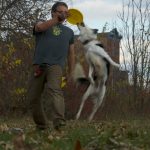 A Take is a cued Bite that replicates the placement and timing of a throw. Usually used with overs, vaults, and flips, the Take is a powerful teaching tool for creating habitual leaping... More a look at Apryl & Jo at 1:10. Apryl is moving into Jo’s line as she’s approaching from the side and it creates a nice intercepting shape. Check it out with the linear approach at 1:20 and you can see that with the linear approach being set, this doesn’t work out as well.
A Take is a cued Bite that replicates the placement and timing of a throw. Usually used with overs, vaults, and flips, the Take is a powerful teaching tool for creating habitual leaping... More a look at Apryl & Jo at 1:10. Apryl is moving into Jo’s line as she’s approaching from the side and it creates a nice intercepting shape. Check it out with the linear approach at 1:20 and you can see that with the linear approach being set, this doesn’t work out as well.
Moving into the dog’s line as they’re on a lateral retrieve means the dog accommodates the handler and works and moves towards the front. Given that the front is not available to the dog they have to run further and wider to get there, allowing for a disc to be thrown that accommodates the dog’s line and creates a nice shape.
There is a lot more to be said about this topic but it’s a bit too much I’ll be working on handler movement and the dog’s line in next week’s DiscDogger Weekly… You’ll have to drop back by to catch it.
See you next week.





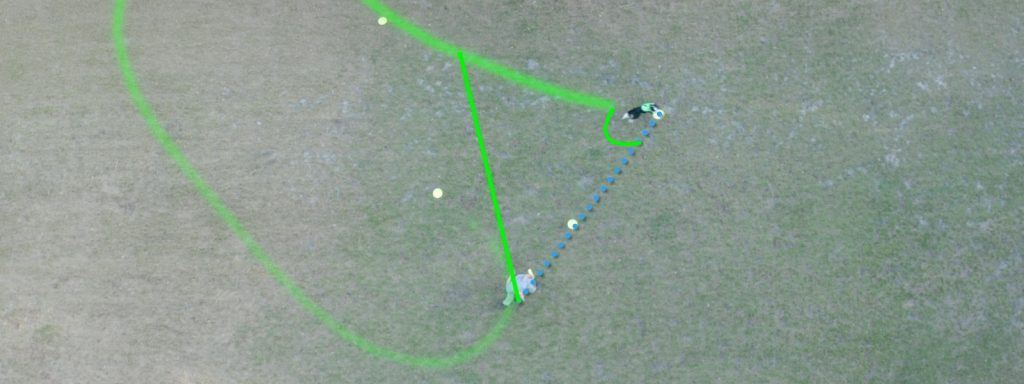
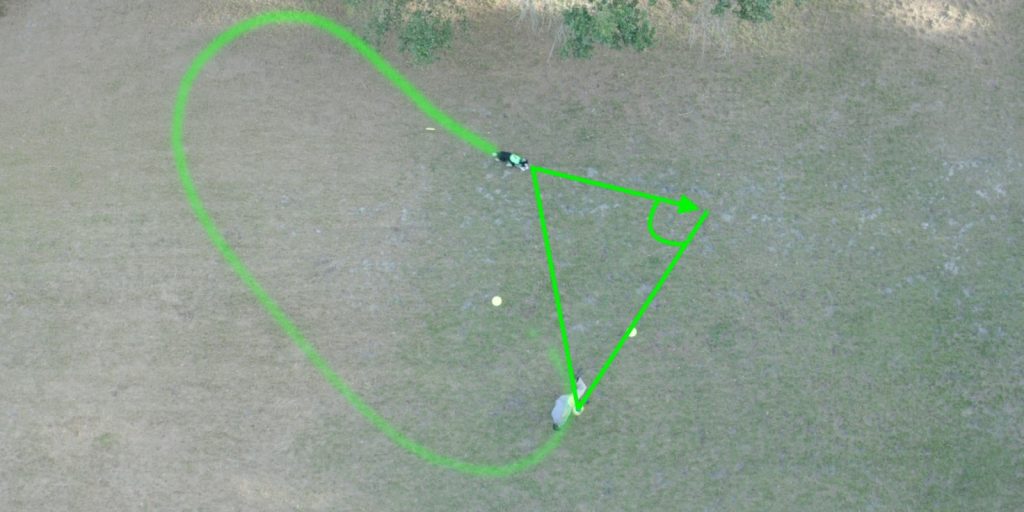
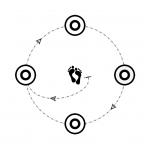
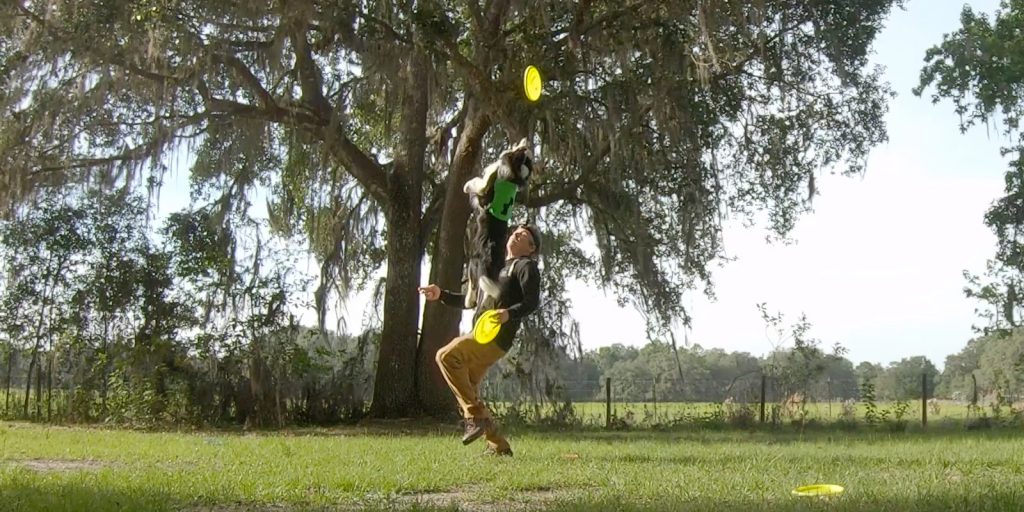

Interesting topic. Am I right that Shape is unrecognized element of Freestyle which enhances the aesthetic perception of the game? Because I saw a lot of sessions containing many cool elements like Vaults, Flips, Overs and etc, but sometimes it looked boring. I didn’t understand why it happened. Now I think that the main reason is linear manner of the game. Could the Toss&Fetch be the root problem of spread of linear movement?
Not just the aesthetic, Oleg. It’s performance as well. Shapes require understanding, planning, and execution by both dog and handler. Shapes are a BIG part of Team Movement and they require great skill and ability.
I believe you are correct about the aesthetic gap in many performances. I think it is often a part of “what’s missing”, and it’s hard to pin down to a concrete, discrete cause…
Toss and Fetch is a cause of a lack of shapes, but it has several other causes – Shapes are not scored in most venues, and many judges don’t understand or recognize the application of shapes – whether it be simply the movement of the dog or the more complex and dynamic Shapes of the team and in the throws themselves.
In addition to the lack of critical feedback on the topic, exploring shapes takes understanding and time. Nobody has time for anything other than sexy vaults and flips and whatnot and without the critical and competitive feedback, Shapes fall by the wayside. Just run your dog in a clockwise circle or out and back and throw in some sexy interior moves and you’re sexy AND competitive.
It frustrates me. Shapes and Team Movement are deep expressions of competent and “sexy” play. Shapes, Flatwork, and Team Movement should be the ultimate equalizer for players without a monster dog or great human athletic skills, and should be the deciding factor between relatively equivalent play, or a heavily weighted aspect of play for teams who execute them well.
Instead players of all skill levels skip them as foundation and future and focus on bumping up the sexy moves – as if the only place to improve is in developing a funky new Over throw, flip delivery, or fidget. This becomes the path to growth and elevated play. The judges wind up agreeing and placing more focus on the fancy new stuff. I just see more foundational gaps and missed opportunities for quality play.
All that said, back to your aesthetic point… There is something special about this kind of play. It tends to show itself in scores in a ‘je ne sais quoi’ – that certain… I don’t know… – manner. While that is tough to pin down and score directly, it does have impact upon scores and the general vibe of play.
So, yea, you’re on point with this comment, and speaking directly to me with your understanding.
Thanks for such detailed answer, Ron! It seems that the issues raised in my question are very relevant and important. I’d like to add that the approach with unfocused Flatwork miss the oneness of session, I think. It deals with freestyle as a collection of discrete tricks. By contrast, strong Flatwork and Shapes make non-stop flow of movements and keep the oneness of session. That’s like dance, I think. May we talk about the oneness as a key criteria of solid game?
I think they are. Other people’s opinion may be different.
It was an excellent comment. Thank you for sharing your thoughts.